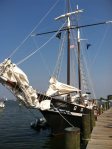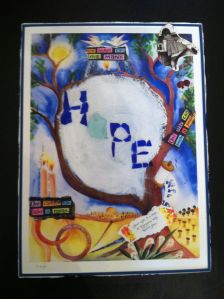J and I knew soon after we were engaged that we wanted to be foster parents. It was an idea I’d had since my mid-20s, but I encountered enough variations of, “are you crazy, why would you want to do THAT?” in my conversations with family, friends and the occasional stranger about my maybe-some-day-motherhood that, within a few years, I stopped talking about this facet of my life plan.
I introduced J to the idea when we attended a conference on adoption and fostering in Washington D.C., the fall before we were married. He was hesitant, until he sat in on a session with a serial foster mother (meaning, foster mother over the years to multiple children, with some of those ending up in adoptions) who clarified how the process worked: it was, she stressed, about fostering the entire family. He could get on board with that. So could I.
It was a six-month process between attending the initial information session and gaining approval, and as of this writing, the time it must have taken to go through the the 72 hours of training, readying the house to pass health and fire inspections, multiple sit-down interviews and a whole host of gathering and submitting forms and questionnaires has receded into a distant memory. Somewhere in there we talked about what our foster parents name would be. Ms. and Mr., the standard fare for older kids, seemed too distant, too informal – though if that’s what they wanted, fine enough. But what if we ended up with younger kids who didn’t yet want to give up the informality that childhood could give you with adults who were virtually strangers, but took care of your needs nonetheless? We settled on Lama for me — short, essentially, for Laura Mom — and Joppa for Jay, a derivative of J and Papa.
It took almost a year after we were approved for us to actually BECOME foster parents, mostly because we were busy gallivanting across the world in our last minutes of full freedom.
We’d signed up for older kids. On purpose. We knew the department often had a harder time placing older kids. And, truth be told, we kind of liked older kids better anyhow. Or at least we liked the idea of them better.
We got a call one September afternoon in 2016 about two siblings, ages 4 and 6, a so-called “emergency placement” — department speak for kids that have just come into “care” that day and needed a place immediately. We were led to believe, in our initial sit-down talk that night with the social worker, that it would probably be temporary: most likely the kids would end up with family at some not-too-far-distant moment in time.
A year and a half later, they were still with us.
We were told we were good foster parents, by the department and by the kids’ family. It was sometimes hard to believe, since in the midst of a temper tantrum (yours OR theirs), you do not always FEEL like a good foster parent.
 While the kids never told us we were good foster parents- though they told us often that they loved us – I realized that perhaps we had done exactly as instructed in that original conference in D.C. after one bedtime conversation with the now-7-year-old. She was telling me a story about some earlier memory of another family member. “You remember,” she stressed, “So-and-so. She watched us sometimes.”
While the kids never told us we were good foster parents- though they told us often that they loved us – I realized that perhaps we had done exactly as instructed in that original conference in D.C. after one bedtime conversation with the now-7-year-old. She was telling me a story about some earlier memory of another family member. “You remember,” she stressed, “So-and-so. She watched us sometimes.”
“No, honey, I don’t remember: Lama and Joppa weren’t around then.”
She full-on stopped and tilted her head to the side, surprised by this information. “You weren’t?”
“Nope,” I answered, shaking my head from side to side while I placed my hand on her leg underneath the comforter.
“Hmmmm,” she said. “It just feels like you and Joppa have ALWAYS been our family.”
A year-a-half after they arrived on our doorstep suddenly, they almost as suddenly left our house.
I originally wrote the below in a very long but very heartfelt post on Facebook.
Its truth still stands, still sums up the wonder, beauty and heartbreak of what it means to foster a family. I wrote it in some nondescript hotel room in Ohio. Today as I sit in my living room, it’s just as true. Heartbreak and healing looks the same no matter where you confront it.
*
We said goodbye to our foster kiddos yesterday (Friday, March 16), just 10 days shy of a year and a half. Long enough to start weaving ourselves into a family. Long enough to understand that blood will always knit you strongly, whether you can see and talk to your family or not. Long enough to learn about a new kind of love, the kind that smarts when it’s time to say goodbye. Short enough to know it was bound to come sometime.
It was hard to be too sad: they are in a good place, and so much good has come out of this transition. We had three weeks to prepare, to say goodbye. We had time to have all good days and good times together. I don’t know, in this line of love, if you can ask for much more.
There’s so much I made sure to say, and so much I left unsaid. On purpose. To say it all would be to say, to acknowledge, that this was goodbye. And none of us wanted to do that.
On the way to drop them off at their new home, I started crying, the kind that leaks out slow but steady. “What’s wrong Lama? Why are you crying?”
“Oh, I’m just sad. We’re going to miss you, and I’m not quite sure what I’m going to do with myself without you guys around. Who is going to wake me up with a little rap on the door in the morning a few minutes earlier than the 7:30 am it’s supposed to be? Without (the 9-year-old) to be tired and grumpy and not-a-morning person with me? Without you guys around to leave tiny little pieces of paper all over the floor that somehow you can’t see to pick up even though it’s all over?” I said this last part with a smile: we’d had this conversation before when I’d exclaimed in my fake-mad voice that I didn’t understand this phenomena and especially not when those same eyes could pick out a pack of gum buried under three layers of purse contents.
They both leaned forward in their seats in the back and let me have my tears, let us have our moment, their hands stretched forward to touch the front seats, close enough so I could squeeze their hands, another way to let them know I’d be OK, but I was still gonna cry about it.
We dropped them off. I gave them kisses on their forehead and cheeks, put my hands on their shoulders, told them I loved them so, so, so much, forever and forever. “See you later,” I said. They hugged Joppa, hard.
We walked out, like it was easy. “I love you,” I said, the same way I had said it every night as I walked out of their room at tuck-in time.
Maybe in some ways it was easy. When I felt lonely today I called their Mom. “How are you doing?” she asked ME. “OK,” I answered. “A little grey around the edges. Right now it feels like maybe they’re just away for a few nights,” I answered, as honest as I come. “I know I’ll have to FEEL it entirely, but I guess I’m still trying to avoid it.”
I told her I had just a glimmer, a 5 percent, maybe only 1 percent glimmer, of what that pain must have been like for her, when they left her.
It doesn’t matter WHY they leave, it only matters that they aren’t there anymore.
Later, I talked to their Nana, the same way we did when the kids were with us, covering present-day and family history in one fell swoop, me pulling out glimmers of where the kids might have gotten this trait or that. I always loved that part. I still did this evening.
Last night I was looking back at pictures. They’ve grown so much, and I’d lost sight of that, the way you do when kids and life are happening every day. They were 4 and 7 when they first showed up, the tops of their heads peering in the screen door as I waved a hearty hello to them and gave a big smile after what I knew would have been a big, scary day. They are 6 and 9 now. I’d already forgotten how much they’d grown. How much her face had changed, picked up glimmers of the teen you can see she will be. Forgot how he’d gone from toddler to joking, farting kindergartner. They grew a lot: but so did I. With them, I found the patience I always worried I didn’t have. I could still use some more, but at least I got a little more.
And then this afternoon I jumped in the car and streaked away, up north to start reporting on a story I’ve already put off for two weeks. I started to listen to an audio book, but my mind started drifting after an hour and I realized I needed to breathe. I listened to the music we played on our road trips, the ones we sang together. I listened to songs that pulled out my longing, songs that pulled out my heartache. And I listened to songs of hope, catching glimmers of the future I’d wish for if you could actually plan life out that way. And I cried, just enough to remind me of what I’m driving away from right now.
The tears were as much about the inevitable goodbyes that come with living as they were about the kids. They were about joy, however fleeting. And they were about the duality of luck, how it makes you a winner even when it means a loss has to be involved, somehow.
Somewhere between the Ohio border and Cleveland, Dave Matthews sang about love:
“Father up above
Why in all this anger do you fill me up with love, love, love?
Love, love, love
Love, love was all around.”
And I thought, “Yes. This. This is why.”
I mean, think about it: it takes an awful lot of grace to let somebody else parent your child in what is otherwise a process that fosters anything but.
It takes an awful lot of trust to open up to a new family.
And that’s exactly what they did: the kids AND their parents and grandparents.
So right now, tonight, sitting in a hotel room in Toledo, Ohio; in this moment; I feel goddamn lucky.
Because I was lucky enough to figure out how to be happy and frustrated and angry at the kids, and still love them fiercely no matter what. And for a woman who never birthed her own kids and wasn’t sure it was entirely possible — even as I professed to others it WAS — right now that seems like everything.
Through this process, we have gained new family, people I can honestly say I love the way you do when someone is blood.
I feel lucky because Joppa and I signed up for this fostering thing because we LIKED- we WANTED- to do what they pitch in recruiting foster homes: fostering the entire family. And we got that this past year and a half. And even though the kids aren’t living with us, we still ARE. And we have seen enough, heard enough, talked to others enough and had our own experiences enough to know that it’s actually NOT that common, these cases when it all opens up and it truly is fostering and becoming one family. They were ours and they ARE theirs.
I’m leaving out a lot of the pain that came before the drop-off: the horror of breaking little hearts when it’s the one thing you professed, felt sure, you would not do. The Tuesday before last, my first real one alone in a week when I wasn’t on the phone or engaged in some action all day long, when the reality settled down on me for the day, the one where the tears slipped out and the sobs poured loud enough to make the dogs worry.
We were, us four, and then yesterday we were not.
So probably this is all just hopeful staunching of the inevitable pain that I’ll have to go through as part of grieving.
But for today, I’ll take it.

 ugo-like cars. New cars are few and far between. Cubans really do still work small farms and harvest tobacco by hand. Cows, tethered by a rope, graze by the roadside. It’s these scenes tourists flock to Cuba to find (along with the crystalline sandy beaches and clear blue seas).
ugo-like cars. New cars are few and far between. Cubans really do still work small farms and harvest tobacco by hand. Cows, tethered by a rope, graze by the roadside. It’s these scenes tourists flock to Cuba to find (along with the crystalline sandy beaches and clear blue seas).





 My back hurts, I can feel each muscle in my legs and arms. I have paint imbedded into vast portions of my hands, and at least five new bruises. Each night I crawl down three feet into a bunk where all my earthly (with me) possessions surround me, scuttling from clothes to books to towel on my knees, hunched over. For the past three days it’s been an endless stream of cleaning, sanding, painting, moving stuff from one place to another, carrying and hauling, with the occasional break for bullshitting. I’m exhausted, too tired to sleep more than five hours a night, really.
My back hurts, I can feel each muscle in my legs and arms. I have paint imbedded into vast portions of my hands, and at least five new bruises. Each night I crawl down three feet into a bunk where all my earthly (with me) possessions surround me, scuttling from clothes to books to towel on my knees, hunched over. For the past three days it’s been an endless stream of cleaning, sanding, painting, moving stuff from one place to another, carrying and hauling, with the occasional break for bullshitting. I’m exhausted, too tired to sleep more than five hours a night, really.
 This race is a goodwill mission- an ambassadorship of sorts, and at the rate the US keeps announcing new allowances in trade and financial regulations, I wouldn’t be surprised if we get to see one of the last visions of a Cuba un-touched by the American way.
This race is a goodwill mission- an ambassadorship of sorts, and at the rate the US keeps announcing new allowances in trade and financial regulations, I wouldn’t be surprised if we get to see one of the last visions of a Cuba un-touched by the American way. 


















